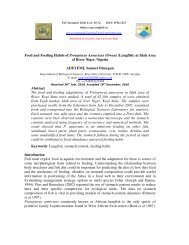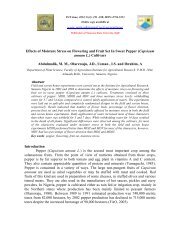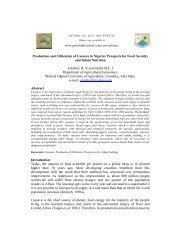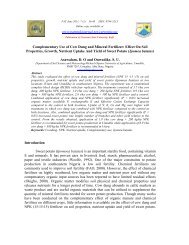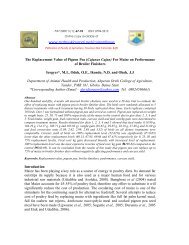Comparison of Four Soil Infiltration Models on A Sandy Soil In Lafia ...
Comparison of Four Soil Infiltration Models on A Sandy Soil In Lafia ...
Comparison of Four Soil Infiltration Models on A Sandy Soil In Lafia ...
Create successful ePaper yourself
Turn your PDF publications into a flip-book with our unique Google optimized e-Paper software.
PAT December, 2011; 7 (2): 116-126 ISSN: 0794-5213<br />
Online copy available at<br />
www.patnsukjournal.net/currentissue<br />
Publicati<strong>on</strong> <str<strong>on</strong>g>of</str<strong>on</strong>g> Nasarawa State University, Keffi<br />
<str<strong>on</strong>g>Comparis<strong>on</strong></str<strong>on</strong>g> <str<strong>on</strong>g>of</str<strong>on</strong>g> <str<strong>on</strong>g>Four</str<strong>on</strong>g> <str<strong>on</strong>g>Soil</str<strong>on</strong>g> <str<strong>on</strong>g><strong>In</strong>filtrati<strong>on</strong></str<strong>on</strong>g> <str<strong>on</strong>g>Models</str<strong>on</strong>g> <strong>on</strong> A <strong>Sandy</strong> <str<strong>on</strong>g>Soil</str<strong>on</strong>g> <strong>In</strong> <strong>Lafia</strong>, Southern<br />
Guinea Savanna Z<strong>on</strong>e <str<strong>on</strong>g>of</str<strong>on</strong>g> Nigeria<br />
Ogbe, V. B. 1 , Jayeoba, O.J. 1 and Ode, S. O. 2<br />
1. Agr<strong>on</strong>omy Department, Faculty <str<strong>on</strong>g>of</str<strong>on</strong>g> Agriculture, Nasarawa State University, Keffi, Shabu-<strong>Lafia</strong> Campus<br />
2. Department <str<strong>on</strong>g>of</str<strong>on</strong>g> Agricultural Engineering Technology, College <str<strong>on</strong>g>of</str<strong>on</strong>g> Agriculture, <strong>Lafia</strong>, Nasarawa State.<br />
Abstract<br />
Predicti<strong>on</strong> <str<strong>on</strong>g>of</str<strong>on</strong>g> soil infiltrati<strong>on</strong> is a major problem due to its variability and proper selecti<strong>on</strong> <str<strong>on</strong>g>of</str<strong>on</strong>g><br />
the technique used to determine the parameters <str<strong>on</strong>g>of</str<strong>on</strong>g> the models which depend <strong>on</strong> the local soil<br />
characteristics. Field experiments were c<strong>on</strong>ducted to assess the predictability <str<strong>on</strong>g>of</str<strong>on</strong>g> kostiakov (K),<br />
modified-Kostiakov (MK), Philip (P) and Hort<strong>on</strong>’s (H) models <strong>on</strong> a sandy soil and to compare<br />
the measured and predicted cumulative infiltrati<strong>on</strong> using these models under local c<strong>on</strong>diti<strong>on</strong>. A<br />
double ring infiltrometer was used to carry out three measurements each at 30m interval in<br />
three different strips <str<strong>on</strong>g>of</str<strong>on</strong>g> 100m l<strong>on</strong>g and 30m wide. A total <str<strong>on</strong>g>of</str<strong>on</strong>g> nine infiltrati<strong>on</strong> test was c<strong>on</strong>ducted<br />
in the field. From the values <str<strong>on</strong>g>of</str<strong>on</strong>g> cumulative infiltrati<strong>on</strong> and time interval measured, the models<br />
parameters were determined. Using the calibrated soil infiltrati<strong>on</strong> models, predicti<strong>on</strong>s <str<strong>on</strong>g>of</str<strong>on</strong>g> the<br />
cumulative infiltrati<strong>on</strong> were made for each strip. GENSTAT package was use to analyze the<br />
predicti<strong>on</strong>s. The result <str<strong>on</strong>g>of</str<strong>on</strong>g> the study shows that the cumulative infiltrati<strong>on</strong> predicted by K, MK,<br />
P and H infiltrati<strong>on</strong> models were very close to the field measurements for all the strips as<br />
indicated from the average values <str<strong>on</strong>g>of</str<strong>on</strong>g> the slope between the measured and predicted by K, MK,<br />
P and H models (1.064, 1.073, 1.044, 1.027) respectively and their coefficient <str<strong>on</strong>g>of</str<strong>on</strong>g><br />
determinati<strong>on</strong>, r 2 (0.997, 0.994, 0.994, 0.999) respectively. The Root Mean Square Error<br />
(RMSE) was used to rank the models in the order H > K > P > KL with values (0.0439,<br />
0.0558, 0.0585, 0.0729) respectively. Hort<strong>on</strong>’s models gave best fit to the measured cumulative<br />
infiltrati<strong>on</strong>, although the other models provided good overall agreement with the field<br />
measured cumulative infiltrati<strong>on</strong> depths.<br />
Keywords: <str<strong>on</strong>g><strong>In</strong>filtrati<strong>on</strong></str<strong>on</strong>g>, <strong>Sandy</strong> <str<strong>on</strong>g>Soil</str<strong>on</strong>g>, Ring <strong>In</strong>filtrometer, <str<strong>on</strong>g><strong>In</strong>filtrati<strong>on</strong></str<strong>on</strong>g> <str<strong>on</strong>g>Models</str<strong>on</strong>g>,<br />
<strong>In</strong>troducti<strong>on</strong><br />
<str<strong>on</strong>g>Soil</str<strong>on</strong>g> water represents a negligible fracti<strong>on</strong> <str<strong>on</strong>g>of</str<strong>on</strong>g> the total water <strong>on</strong> our planet, but it is<br />
undoubtedly <strong>on</strong>e <str<strong>on</strong>g>of</str<strong>on</strong>g> the most important as it plays a vital role in water availability for<br />
plants in the various root z<strong>on</strong>es <str<strong>on</strong>g>of</str<strong>on</strong>g> the soil (Musa and Adeoye, 2010). Rainfall or<br />
irrigati<strong>on</strong> water is divided into two parts by infiltrati<strong>on</strong>. One part goes through overland<br />
flow and stream channels to the sea as surface run<str<strong>on</strong>g>of</str<strong>on</strong>g>f; the other part goes initially into<br />
the soil and hence, through groundwater flow into the stream or else is returned to the<br />
atmosphere by evaporative processes (Hickok and Osborn, 1969).<br />
<str<strong>on</strong>g><strong>In</strong>filtrati<strong>on</strong></str<strong>on</strong>g> is the process <str<strong>on</strong>g>of</str<strong>on</strong>g> water movement from the ground surface into the soil and<br />
is an important comp<strong>on</strong>ent in the hydrological cycle (Haghaibi et. al., 2011) while soil<br />
water movement or percolati<strong>on</strong> is the process <str<strong>on</strong>g>of</str<strong>on</strong>g> water flow from <strong>on</strong>e point to another<br />
within the soil. <str<strong>on</strong>g><strong>In</strong>filtrati<strong>on</strong></str<strong>on</strong>g> and percolati<strong>on</strong> cannot be treated independently, because the
PAT 2011; 7 (2): 116 -126: ISSN: 0794-5213; Ogbe et al; <str<strong>on</strong>g>Comparis<strong>on</strong></str<strong>on</strong>g> <str<strong>on</strong>g>of</str<strong>on</strong>g> <str<strong>on</strong>g>Four</str<strong>on</strong>g> <str<strong>on</strong>g>Soil</str<strong>on</strong>g> <str<strong>on</strong>g><strong>In</strong>filtrati<strong>on</strong></str<strong>on</strong>g> <str<strong>on</strong>g>Models</str<strong>on</strong>g> ….. 117<br />
rate <str<strong>on</strong>g>of</str<strong>on</strong>g> infiltrati<strong>on</strong> is c<strong>on</strong>trolled by the rate <str<strong>on</strong>g>of</str<strong>on</strong>g> percolati<strong>on</strong> below the surface (Hsu et. al.,<br />
2002). However, infiltrati<strong>on</strong> has received a great deal <str<strong>on</strong>g>of</str<strong>on</strong>g> attenti<strong>on</strong> from soil and water<br />
scientists because <str<strong>on</strong>g>of</str<strong>on</strong>g> its fundamental role in land-surface and subsurface hydrology,<br />
irrigati<strong>on</strong> and agriculture (Mishra et. al., 2003). Through infiltrati<strong>on</strong> rainfall or<br />
irrigati<strong>on</strong> water is turned into soil water and used to sustain the growth <str<strong>on</strong>g>of</str<strong>on</strong>g> crops,<br />
vegetati<strong>on</strong>, replenish ground water supply to wells, springs and streams (Rawls et al.,<br />
1993). It is key to soil and water c<strong>on</strong>servati<strong>on</strong>, and irrigati<strong>on</strong> management because it<br />
determines the amount <str<strong>on</strong>g>of</str<strong>on</strong>g> run<str<strong>on</strong>g>of</str<strong>on</strong>g>f over the soil surface during rainfalls or irrigati<strong>on</strong>s<br />
(Oku and Aiyelari, 2011).<br />
<str<strong>on</strong>g><strong>In</strong>filtrati<strong>on</strong></str<strong>on</strong>g> characteristics <str<strong>on</strong>g>of</str<strong>on</strong>g> the soil are quantified when field infiltrati<strong>on</strong> data are fitted<br />
mathematically to infiltrati<strong>on</strong> models (Oku and Aiyelari, 2011). Despite advances in the<br />
estimati<strong>on</strong> from soil physical properties, surface irrigati<strong>on</strong> practiti<strong>on</strong>ers still use<br />
empirical infiltrati<strong>on</strong> models. However, not all models are applicable in all soils.<br />
Several studies have been c<strong>on</strong>ducted to establish models parameters, validate models or<br />
compare models efficiencies and applicability for different soil c<strong>on</strong>diti<strong>on</strong>s. Igbadun and<br />
Idris (2007) investigated the capacity <str<strong>on</strong>g>of</str<strong>on</strong>g> Kostiakov’s, Philip’s, Kostiakov-Lewis’ and<br />
modified Kostiakov infiltrati<strong>on</strong> models to describe water infiltrati<strong>on</strong> into a<br />
hydromorphic soil <str<strong>on</strong>g>of</str<strong>on</strong>g> the flood plain in Zango village, Samaru, Zaria, Nigeria. They<br />
reported that although the four models provided good overall agreement, Kostiakov’s<br />
and modified Kostiakov model were found to provide best fit. Oku and Aiyelari (2011)<br />
deduced that Philip’s model was more suitable than Kostiakov’s model from a study <str<strong>on</strong>g>of</str<strong>on</strong>g><br />
the infiltrati<strong>on</strong> capacity <str<strong>on</strong>g>of</str<strong>on</strong>g> the soil (<strong>In</strong>ceptisols) <str<strong>on</strong>g>of</str<strong>on</strong>g> the humid forest in southern Nigeria<br />
using the two models. Musa and Adeoye (2010) in their study to adapt infiltrati<strong>on</strong><br />
equati<strong>on</strong>s to the soil <str<strong>on</strong>g>of</str<strong>on</strong>g> the permanent site farm <str<strong>on</strong>g>of</str<strong>on</strong>g> the Federal University <str<strong>on</strong>g>of</str<strong>on</strong>g><br />
Technology, Minna, in the Guinea Savannah Z<strong>on</strong>e <str<strong>on</strong>g>of</str<strong>on</strong>g> Nigeria stated that Kostiakov’s<br />
model showed a better performance over those <str<strong>on</strong>g>of</str<strong>on</strong>g> Philip’s and Hort<strong>on</strong>’s models.<br />
Mbagwu (1997) reported that Philip’s model would always fail to predict measured<br />
infiltrati<strong>on</strong>s when the assumpti<strong>on</strong>s <str<strong>on</strong>g>of</str<strong>on</strong>g> the model are not met during the infiltrati<strong>on</strong><br />
process. However, the need for c<strong>on</strong>tinuous in-depth and field specific study <str<strong>on</strong>g>of</str<strong>on</strong>g> the<br />
applicability <str<strong>on</strong>g>of</str<strong>on</strong>g> infiltrati<strong>on</strong> equati<strong>on</strong>s cannot be over emphasized since models<br />
parameters and performance vary for different soils and with time.<br />
<strong>In</strong> the study reported herein, the performance <str<strong>on</strong>g>of</str<strong>on</strong>g> four infiltrati<strong>on</strong> models (Kostiakov,<br />
modified Kostiakov, Philip and Hort<strong>on</strong>) in a sandy soil was evaluated. The general<br />
objective <str<strong>on</strong>g>of</str<strong>on</strong>g> the study was to test the competence <str<strong>on</strong>g>of</str<strong>on</strong>g> the four models to predict water<br />
infiltrati<strong>on</strong> in the soil type. The specific objectives are to estimate the models<br />
parameters and to compare the cumulative infiltrati<strong>on</strong> depths estimated by the models<br />
with those measured in the field.
PAT 2011; 7 (2): 116 -126: ISSN: 0794-5213; Ogbe et al; <str<strong>on</strong>g>Comparis<strong>on</strong></str<strong>on</strong>g> <str<strong>on</strong>g>of</str<strong>on</strong>g> <str<strong>on</strong>g>Four</str<strong>on</strong>g> <str<strong>on</strong>g>Soil</str<strong>on</strong>g> <str<strong>on</strong>g><strong>In</strong>filtrati<strong>on</strong></str<strong>on</strong>g> <str<strong>on</strong>g>Models</str<strong>on</strong>g> ….. 118<br />
Materials and Methods<br />
Study Area<br />
The experiment was carried out at the Research and Teaching Farm <str<strong>on</strong>g>of</str<strong>on</strong>g> the College <str<strong>on</strong>g>of</str<strong>on</strong>g><br />
Agriculture, <strong>Lafia</strong> (08 o 35’N, 08 o 33’E), located in the Guinea Savanna Z<strong>on</strong>e <str<strong>on</strong>g>of</str<strong>on</strong>g> North<br />
Central Nigeria at an attitude <str<strong>on</strong>g>of</str<strong>on</strong>g> 177m above sea level. The mean m<strong>on</strong>thly maximum<br />
and minimum temperature range between 35.06 0 C – 36.40 0 C and 20.16 o C – 20.50 0 C<br />
respectively while the mean m<strong>on</strong>thly relative humidity and rainfall are 74.67% and<br />
168.90mm respectively.<br />
Field Measurements<br />
Field experiment was carried out at the College <str<strong>on</strong>g>of</str<strong>on</strong>g> Agriculture experimental farm, <strong>Lafia</strong>.<br />
The porti<strong>on</strong> <str<strong>on</strong>g>of</str<strong>on</strong>g> the field used was 100m l<strong>on</strong>g by 90m wide. The field was divided into<br />
three strips <str<strong>on</strong>g>of</str<strong>on</strong>g> 100m by 30m. Three points at 30m interval the length was marked out<br />
and infiltrati<strong>on</strong> test carried out at those points for each strip. <str<strong>on</strong>g>Soil</str<strong>on</strong>g> samples were also<br />
collected from the adjacent area <str<strong>on</strong>g>of</str<strong>on</strong>g> the marked points at 0-15 cm and 15-30 cm depths<br />
for soil analysis. <str<strong>on</strong>g><strong>In</strong>filtrati<strong>on</strong></str<strong>on</strong>g> measurement was carried out using a double ring<br />
infiltrometer. The infiltrometer was driven into the soil to a depth <str<strong>on</strong>g>of</str<strong>on</strong>g> 10cm and a<br />
measuring tape was fixed inside the inner cylinder from where readings were taken.<br />
Readings were then taken at intervals to determine the amount <str<strong>on</strong>g>of</str<strong>on</strong>g> water infiltrated<br />
during the time interval with an average infiltrati<strong>on</strong> head <str<strong>on</strong>g>of</str<strong>on</strong>g> 5cm maintained. The<br />
infiltrati<strong>on</strong> rate and the cumulative infiltrati<strong>on</strong> were then calculated.<br />
Moisture c<strong>on</strong>tent was determined by gravimetric method. The soil texture <str<strong>on</strong>g>of</str<strong>on</strong>g> the site<br />
was determined by mechanical analysis method. The United States Department <str<strong>on</strong>g>of</str<strong>on</strong>g><br />
Agriculture (USDA) Textural Classificati<strong>on</strong> Triangle was used to classify the soil based<br />
<strong>on</strong> the results obtained from the analysis.<br />
<str<strong>on</strong>g><strong>In</strong>filtrati<strong>on</strong></str<strong>on</strong>g> <str<strong>on</strong>g>Models</str<strong>on</strong>g> Evaluated<br />
Several models including Kostiakov (K), modified Kostiakov (MK), Philip (P) and<br />
Hort<strong>on</strong>’s (H) models have been developed for m<strong>on</strong>itoring infiltrati<strong>on</strong> process.<br />
Kostiakov and Modified Kostiakov equati<strong>on</strong>s<br />
Kostiakov (1932) and Lewis (1938) independently proposed a simple empirical<br />
infiltrati<strong>on</strong> equati<strong>on</strong> based <strong>on</strong> curve fitting data. It relates infiltrati<strong>on</strong> to time as a power<br />
functi<strong>on</strong> as presented by Eq: (1)<br />
Z = kt a (1)<br />
where, Z = cumulative infiltrati<strong>on</strong> (cm/hr), t = time from start <str<strong>on</strong>g>of</str<strong>on</strong>g> infiltrati<strong>on</strong> (min), k, a<br />
= c<strong>on</strong>stants that depends <strong>on</strong> the soil and initial c<strong>on</strong>diti<strong>on</strong>s. A better representati<strong>on</strong> <str<strong>on</strong>g>of</str<strong>on</strong>g> the
PAT 2011; 7 (2): 116 -126: ISSN: 0794-5213; Ogbe et al; <str<strong>on</strong>g>Comparis<strong>on</strong></str<strong>on</strong>g> <str<strong>on</strong>g>of</str<strong>on</strong>g> <str<strong>on</strong>g>Four</str<strong>on</strong>g> <str<strong>on</strong>g>Soil</str<strong>on</strong>g> <str<strong>on</strong>g><strong>In</strong>filtrati<strong>on</strong></str<strong>on</strong>g> <str<strong>on</strong>g>Models</str<strong>on</strong>g> ….. 119<br />
depth infiltrated over a l<strong>on</strong>g period <str<strong>on</strong>g>of</str<strong>on</strong>g> time is given by the modified Kostiakov equati<strong>on</strong><br />
expressed as<br />
Z = kt a + f 0 t (2)<br />
in which f 0 is the l<strong>on</strong>g term steady or basic infiltrati<strong>on</strong> rate in units <str<strong>on</strong>g>of</str<strong>on</strong>g> volume per unit<br />
length per unit time and width and other parameters as previously defined. The<br />
Kostiakov and modified Kostiakov tend to be the most preferred infiltrati<strong>on</strong> models<br />
used in surface irrigati<strong>on</strong> applicati<strong>on</strong> because <str<strong>on</strong>g>of</str<strong>on</strong>g> their simplicity, capability <str<strong>on</strong>g>of</str<strong>on</strong>g> fitting<br />
most infiltrati<strong>on</strong> data and probably because it is less restrictive as to the mode <str<strong>on</strong>g>of</str<strong>on</strong>g> water<br />
applicati<strong>on</strong> than some other models.<br />
Philip’s equati<strong>on</strong><br />
Philip (1957b) proposed that by truncating his series soluti<strong>on</strong> for infiltrati<strong>on</strong> from a<br />
pounded surface after the first two terms, a c<strong>on</strong>cise infiltrati<strong>on</strong> rate equati<strong>on</strong> could be<br />
obtained which would be useful for small times. The resulting equati<strong>on</strong> is<br />
Z = St 0.5 + At (3)<br />
Where, S = Sorptivity, A = Parameter related to saturated hydraulic c<strong>on</strong>ductivity, other<br />
parameters as previously defined. Parameter ‘A’ is c<strong>on</strong>sidered roughly identical to<br />
steady infiltrati<strong>on</strong>. Parameter ‘S’ is sensitive to antecedent soil moisture c<strong>on</strong>diti<strong>on</strong> and<br />
relatively less sensitive to the parameter ‘A’ (Al-Azawi, 1985).<br />
Hort<strong>on</strong> equati<strong>on</strong><br />
Hort<strong>on</strong> (1940) proposed an infiltrati<strong>on</strong> equati<strong>on</strong> derived from work and energy<br />
principles as<br />
z = f + (f 0 - f) e -βt (4)<br />
where, f is the steady state infiltrati<strong>on</strong> rate, f 0 is the infiltrati<strong>on</strong> rate at time, t = 0, β is the<br />
infiltrati<strong>on</strong> decay factor, other parameters as previously defined. The rate <str<strong>on</strong>g>of</str<strong>on</strong>g> decrease <str<strong>on</strong>g>of</str<strong>on</strong>g><br />
infiltrati<strong>on</strong> rate (z) to steady state infiltrati<strong>on</strong> (f) is determined by β. Hort<strong>on</strong> (1940) also<br />
attributed this decrease primarily to factors operating at the soil surface rather than to<br />
flow processes within the soil.<br />
<strong>In</strong>tegrating Eq: (6) gives the cumulative infiltrati<strong>on</strong> <str<strong>on</strong>g>of</str<strong>on</strong>g> the Hort<strong>on</strong> model and expressed<br />
as<br />
Z = ft + (f0 - f)β -1 (1 – e -βt ) (5)<br />
Estimati<strong>on</strong> <str<strong>on</strong>g>of</str<strong>on</strong>g> <str<strong>on</strong>g><strong>In</strong>filtrati<strong>on</strong></str<strong>on</strong>g> Characteristics<br />
Optimal values <str<strong>on</strong>g>of</str<strong>on</strong>g> the parameters <str<strong>on</strong>g>of</str<strong>on</strong>g> the four models were estimated using regressi<strong>on</strong><br />
module <str<strong>on</strong>g>of</str<strong>on</strong>g> the GENSTAT package. To estimate the Kostiakov model parameters, the<br />
cumulative infiltrati<strong>on</strong> and time data were subjected to a n<strong>on</strong>-linear regressi<strong>on</strong> analysis<br />
(z = kt a ) to find the parameters k and a. Using the final infiltrati<strong>on</strong> rate, the cumulative
PAT 2011; 7 (2): 116 -126: ISSN: 0794-5213; Ogbe et al; <str<strong>on</strong>g>Comparis<strong>on</strong></str<strong>on</strong>g> <str<strong>on</strong>g>of</str<strong>on</strong>g> <str<strong>on</strong>g>Four</str<strong>on</strong>g> <str<strong>on</strong>g>Soil</str<strong>on</strong>g> <str<strong>on</strong>g><strong>In</strong>filtrati<strong>on</strong></str<strong>on</strong>g> <str<strong>on</strong>g>Models</str<strong>on</strong>g> ….. 120<br />
infiltrati<strong>on</strong> and time data were subjected to a n<strong>on</strong>-linear regressi<strong>on</strong> analysis (z – ft = kt a )<br />
to determine parameters k and a for the modified Kostiakov model. The Philip’s model<br />
parameters were estimated by subjecting the cumulative infiltrati<strong>on</strong> and time data to a<br />
linear regressi<strong>on</strong> analysis (zt -0.5 = S + At 0.5 ) to find the parameters S and A. Hort<strong>on</strong>’s<br />
model parameters were estimated by subjecting the infiltrati<strong>on</strong> rate and time data to a<br />
semi n<strong>on</strong>-linear regressi<strong>on</strong> analysis<br />
to determine<br />
parameters f o and β.<br />
Statistical Analysis<br />
The accuracy <str<strong>on</strong>g>of</str<strong>on</strong>g> the different equati<strong>on</strong>s for predicting the cumulative infiltrati<strong>on</strong> were<br />
evaluated by comparing the observed values <str<strong>on</strong>g>of</str<strong>on</strong>g> measurement <strong>on</strong> the field and the<br />
predicted values based <strong>on</strong> the fitted equati<strong>on</strong>. The data were then subjected to a linear<br />
regressi<strong>on</strong> analysis and the t-paired test using the GENSTAT.<br />
Results and Discussi<strong>on</strong><br />
<str<strong>on</strong>g>Soil</str<strong>on</strong>g> Properties<br />
The result <str<strong>on</strong>g>of</str<strong>on</strong>g> analysis <str<strong>on</strong>g>of</str<strong>on</strong>g> soil physical properties <str<strong>on</strong>g>of</str<strong>on</strong>g> the study area is presented in table 1.<br />
The results showed that the texture <str<strong>on</strong>g>of</str<strong>on</strong>g> the field surface (0 - 15) cm and the sub-surface<br />
(15 - 30) cm depths for the three sampled strips were predominantly sandy, having sand<br />
fracti<strong>on</strong> ranging from 88 – 92 %. The average bulk densities are 1.54g/cm 3 and<br />
1.55g/cm 3 with average porosities <str<strong>on</strong>g>of</str<strong>on</strong>g> 42.01% and 41.63% at the 0 – 15cm and 15 –<br />
30cm depth respectively. The average initial antecedent moisture c<strong>on</strong>tents are 4.43%<br />
and 4.97% at the surface and subsurface depths respectively.<br />
Table 1: Average soil properties at different depths.<br />
Strip Depth (cm) Clay (%) Silt (%) Sand (%) Texture .B.D (g/cm 3 ) Porosity (%) MC(%)<br />
A 0 – 15 8.6 3.4 88 <strong>Sandy</strong> 1.46 44.90 4.70<br />
B<br />
C<br />
15 – 30<br />
0 – 15<br />
15 – 30<br />
0 – 15<br />
15 – 30<br />
6.6<br />
8.6<br />
6.6<br />
10.6<br />
6.6<br />
3.4<br />
1.4<br />
1.4<br />
1.4<br />
1.4<br />
90<br />
90<br />
92<br />
88<br />
92<br />
MC - Moisture c<strong>on</strong>tent. B.D – Bulk Density<br />
<strong>Sandy</strong><br />
<strong>Sandy</strong><br />
<strong>Sandy</strong><br />
<strong>Sandy</strong><br />
<strong>Sandy</strong><br />
1.43<br />
1.74<br />
1.75<br />
1.41<br />
1.46<br />
46.03<br />
34.33<br />
33.96<br />
46.79<br />
44.90<br />
5.30<br />
4.20<br />
5.20<br />
4.40<br />
4.40<br />
<str<strong>on</strong>g><strong>In</strong>filtrati<strong>on</strong></str<strong>on</strong>g> Parameters<br />
The average infiltrati<strong>on</strong> parameters <str<strong>on</strong>g>of</str<strong>on</strong>g> the four infiltrati<strong>on</strong> equati<strong>on</strong>s for the three strips<br />
are shown in Table 2.
PAT 2011; 7 (2): 116 -126: ISSN: 0794-5213; Ogbe et al; <str<strong>on</strong>g>Comparis<strong>on</strong></str<strong>on</strong>g> <str<strong>on</strong>g>of</str<strong>on</strong>g> <str<strong>on</strong>g>Four</str<strong>on</strong>g> <str<strong>on</strong>g>Soil</str<strong>on</strong>g> <str<strong>on</strong>g><strong>In</strong>filtrati<strong>on</strong></str<strong>on</strong>g> <str<strong>on</strong>g>Models</str<strong>on</strong>g> ….. 121<br />
Table 2: Estimated values <str<strong>on</strong>g>of</str<strong>on</strong>g> the models parameters for the three strips.<br />
Stirp Kostiakov Modified Kostiakov Philip Hort<strong>on</strong><br />
label k a k a f S A f c f 0 β<br />
A 1.3868 0.781 1.652 0.494 0.333 1.851 0.307 20 59.92 -1.998<br />
B 1.5596 0.784 1.722 0.546 0.350 2.138 0.345 21 67.53 -1.696<br />
C 1.5171 0.785 1.734 0.529 0.350 2.131 0.333 21 70.50 -1.968<br />
The average values <str<strong>on</strong>g>of</str<strong>on</strong>g> the time exp<strong>on</strong>ent <str<strong>on</strong>g>of</str<strong>on</strong>g> Kostiakov equati<strong>on</strong> was observed to range<br />
between 0.781 and 0.785 which were in accordance to the theory <str<strong>on</strong>g>of</str<strong>on</strong>g> infiltrati<strong>on</strong> that puts<br />
the value to be positive and always less than unity. However, most observed values lies<br />
between 0.2 and 0.9 (Blair and Reddell, 1983; Serralheiro, 1988). The values <str<strong>on</strong>g>of</str<strong>on</strong>g> these<br />
parameters do not possess any specific physical meaning; however they reflect the<br />
effect <str<strong>on</strong>g>of</str<strong>on</strong>g> soil physical properties <str<strong>on</strong>g>of</str<strong>on</strong>g> influence <strong>on</strong> infiltrati<strong>on</strong> as well as antecedent soil<br />
moisture c<strong>on</strong>tent and surface c<strong>on</strong>diti<strong>on</strong>s (Zerihun and Sanchez, 2003). The equati<strong>on</strong>s<br />
describe the measured infiltrati<strong>on</strong> curve and given the soil and initial water c<strong>on</strong>diti<strong>on</strong>,<br />
allow predicti<strong>on</strong> <str<strong>on</strong>g>of</str<strong>on</strong>g> an infiltrati<strong>on</strong> curve using the same c<strong>on</strong>stants developed for those<br />
c<strong>on</strong>diti<strong>on</strong>s.<br />
Tables 3a – c show the models predicted cumulative infiltrati<strong>on</strong> for strips A to C<br />
respectively, and the measured cumulative infiltrati<strong>on</strong> used for comparis<strong>on</strong>. The models<br />
predicted values closely agree with that measured from the field for all the strips as seen<br />
in the tables. However, Kostiakov, modified Kostiakov and Philip’s models averagely<br />
over predicted at the initial stages up to the 11 th minute, under predicted at the middle to<br />
the 108 th minute period and then over predicted towards the end respectively. Hort<strong>on</strong>’s<br />
model, however over predicted slightly all through the period for all the strips.<br />
Table 3a: Cumulative infiltrati<strong>on</strong> (cm) predicted by the models compared with<br />
measured values for strip A.<br />
Time (Min) Measured Kostiakov Modified Kostiakov Philip Hort<strong>on</strong><br />
3 2.9 3.3 3.8 4.1 2.9<br />
6 5.5 5.6 6.0 6.4 5.6<br />
11 9.5 9.0 9.1 9.5 9.6<br />
16 13.0 12.1 11.8 12.3 13.7<br />
26 19.0 17.7 16.9 17.4 20.1<br />
36 24.2 22.8 21.7 22.2 26.0<br />
46 29.0 27.6 26.3 26.7 31.1<br />
60 35.0 33.9 32.5 32.8 37.3<br />
74 40.6 40.0 38.5 38.6 42.9<br />
88 46.0 45.8 44.4 44.4 48.3<br />
108 53.1 53.7 52.7 52.4 55.4<br />
128 59.9 61.3 60.8 60.2 62.3<br />
148 66.7 68.7 68.8 68.0 69.2
PAT 2011; 7 (2): 116 -126: ISSN: 0794-5213; Ogbe et al; <str<strong>on</strong>g>Comparis<strong>on</strong></str<strong>on</strong>g> <str<strong>on</strong>g>of</str<strong>on</strong>g> <str<strong>on</strong>g>Four</str<strong>on</strong>g> <str<strong>on</strong>g>Soil</str<strong>on</strong>g> <str<strong>on</strong>g><strong>In</strong>filtrati<strong>on</strong></str<strong>on</strong>g> <str<strong>on</strong>g>Models</str<strong>on</strong>g> ….. 122<br />
168 73.5 75.9 76.7 75.6 75.9<br />
188 80.3 82.8 84.6 83.1 82.5<br />
208 87.1 89.6 92.3 90.6 89.4<br />
Table 3b: Cumulative infiltrati<strong>on</strong> (cm) predicted by the models compared with measured values<br />
for strip B.<br />
Time (Min) Measured Kostiakov Modified Kostiakov Philip Hort<strong>on</strong><br />
3 3.2 3.7 4.2 4.7 3.3<br />
6 6.1 6.4 6.7 7.3 6.4<br />
11 10.5 10.2 10.2 10.9 11.0<br />
16 14.5 13.7 13.4 14.1 15.8<br />
26 21.7 20.1 19.3 19.9 23.2<br />
36 28.1 25.9 24.8 25.3 30.1<br />
46 33.7 31.4 30.0 30.4 36.2<br />
60 40.7 38.7 37.1 37.3 43.4<br />
74 47.3 45.6 44.0 43.9 49.9<br />
88 53.3 52.2 50.7 50.4 56.0<br />
108 61.0 61.3 60.0 59.5 63.9<br />
128 68.4 70.0 69.2 68.4 71.4<br />
148 75.4 78.5 78.2 77.1 78.9<br />
168 82.4 86.6 87.1 85.7 86.0<br />
188 89.4 94.6 95.8 94.2 93.0<br />
208 96.4 102.4 104.6 102.6 100.2<br />
Table 3c: Cumulative infiltrati<strong>on</strong> (cm) predicted by the models compared with<br />
measured values for strip C.<br />
Time (Min) Measured Kostiakov Modified Kostiakov Philip Hort<strong>on</strong><br />
3 3.1 3.6 4.2 4.7 3.4<br />
6 5.9 6.2 6.6 7.2 6.6<br />
11 10.2 10.0 10.0 10.7 11.3<br />
16 14.2 13.4 13.1 13.9 16.0<br />
26 21.5 19.6 18.8 19.5 23.4<br />
36 28.0 25.3 24.1 24.8 30.0<br />
46 33.7 30.6 29.2 29.8 35.8<br />
60 40.5 37.7 36.1 36.5 42.6<br />
74 46.5 44.5 42.8 43.0 48.8<br />
88 52.1 51.0 49.3 49.3 54.6<br />
108 59.4 59.9 58.4 58.1 62.2<br />
128 66.3 68.4 67.4 66.7 69.5<br />
148 73.2 76.7 76.2 75.2 76.8<br />
168 80.1 84.7 84.9 83.6 83.9<br />
188 87.0 92.5 93.5 91.8 90.8<br />
208 93.9 100.2 102.0 100.0 98.0
PAT 2011; 7 (2): 116 -126: ISSN: 0794-5213; Ogbe et al; <str<strong>on</strong>g>Comparis<strong>on</strong></str<strong>on</strong>g> <str<strong>on</strong>g>of</str<strong>on</strong>g> <str<strong>on</strong>g>Four</str<strong>on</strong>g> <str<strong>on</strong>g>Soil</str<strong>on</strong>g> <str<strong>on</strong>g><strong>In</strong>filtrati<strong>on</strong></str<strong>on</strong>g> <str<strong>on</strong>g>Models</str<strong>on</strong>g> ….. 123<br />
Predicti<strong>on</strong> <str<strong>on</strong>g>of</str<strong>on</strong>g> Cumulative <str<strong>on</strong>g><strong>In</strong>filtrati<strong>on</strong></str<strong>on</strong>g> by the Model<br />
Predicti<strong>on</strong>s were made for each <str<strong>on</strong>g>of</str<strong>on</strong>g> the strips using all the four models and the predicted<br />
cumulative infiltrati<strong>on</strong> were compared with the measured cumulative infiltrati<strong>on</strong>. The<br />
cumulative infiltrati<strong>on</strong> values predicted using the infiltrati<strong>on</strong> models and those<br />
measured were plotted against each other and fitted with a linear equati<strong>on</strong> with zero<br />
intercept to verify the validity <str<strong>on</strong>g>of</str<strong>on</strong>g> each predicti<strong>on</strong>. The slope <str<strong>on</strong>g>of</str<strong>on</strong>g> the line <str<strong>on</strong>g>of</str<strong>on</strong>g> best fit and its<br />
coefficient <str<strong>on</strong>g>of</str<strong>on</strong>g> determinati<strong>on</strong> (R 2 ) for each model and strip are given in tables 4a – c<br />
respectively. To check the discrepancies between the predicted and the measured<br />
values, paired t-test and Root Mean Square Error (RMSE) were used. Values <str<strong>on</strong>g>of</str<strong>on</strong>g> the t-<br />
test and RMSE for each model and strip are also presented in tables 4a – c respectively.<br />
The result <str<strong>on</strong>g>of</str<strong>on</strong>g> the slope between the predicted and measured values shows that the<br />
models satisfactorily predicted the cumulative infiltrati<strong>on</strong> for all the strips with values<br />
ranging from 1.027 to 1.080 and the coefficient <str<strong>on</strong>g>of</str<strong>on</strong>g> determinati<strong>on</strong> values lay between<br />
0.991 and 0.999, which are very high, further shows good predictability <str<strong>on</strong>g>of</str<strong>on</strong>g> the models<br />
for all the strips.<br />
Statistical results indicates that all the models used satisfactorily predicted the<br />
cumulative infiltrati<strong>on</strong> given that the t-calculated values for all the models in each strip<br />
are less than the t-table value (2.131). Therefore, it can be c<strong>on</strong>cluded that the fieldmeasured<br />
cumulative infiltrati<strong>on</strong> do not differ from those predicted by the models since<br />
the observed difference can be accounted for by experimental error. However, RMSE<br />
was used to determine the accuracy <str<strong>on</strong>g>of</str<strong>on</strong>g> predicti<strong>on</strong> <str<strong>on</strong>g>of</str<strong>on</strong>g> the cumulative infiltrati<strong>on</strong> in the<br />
order K > P > H > KL for strip A and H > K > P > KL for strips B and C respectively.<br />
Table 4a: Values <str<strong>on</strong>g>of</str<strong>on</strong>g> the performance indices between the predicted and measured<br />
cumulative infiltrati<strong>on</strong> for strip A.<br />
<str<strong>on</strong>g>Models</str<strong>on</strong>g> Kostiakov Modified Kostiakov Philip Hort<strong>on</strong><br />
R 2 0.999 0.996 0.997 0.999<br />
Slope 1.042 1.061 1.036 1.027<br />
t-test -0.7731 -0.1591 0.1334 -7.1677<br />
RMSE 0.0356 0.0604 0.0450 0.0474<br />
Table 4b: Values <str<strong>on</strong>g>of</str<strong>on</strong>g> the performance indices between the predicted and measured<br />
cumulative infiltrati<strong>on</strong> for strip B.<br />
<str<strong>on</strong>g>Models</str<strong>on</strong>g> Kostiakov Modified Kostiakov Philip Hort<strong>on</strong><br />
R 2 0.997 0.993 0.993 0.999<br />
Slope 1.065 1.076 1.048 1.037<br />
t-test -0.8512 -0.2176 0.0333 -7.5251<br />
RMSE 0.0585 0.0779 0.0635 0.0562
PAT 2011; 7 (2): 116 -126: ISSN: 0794-5213; Ogbe et al; <str<strong>on</strong>g>Comparis<strong>on</strong></str<strong>on</strong>g> <str<strong>on</strong>g>of</str<strong>on</strong>g> <str<strong>on</strong>g>Four</str<strong>on</strong>g> <str<strong>on</strong>g>Soil</str<strong>on</strong>g> <str<strong>on</strong>g><strong>In</strong>filtrati<strong>on</strong></str<strong>on</strong>g> <str<strong>on</strong>g>Models</str<strong>on</strong>g> ….. 124<br />
Table 4c: Values <str<strong>on</strong>g>of</str<strong>on</strong>g> the performance indices between the predicted and measured<br />
cumulative infiltrati<strong>on</strong> for strip C.<br />
<str<strong>on</strong>g>Models</str<strong>on</strong>g> Kostiakov Modified Kostiakov Philip Hort<strong>on</strong><br />
R 2 0.996 0.991 0.992 0.999<br />
Slope 1.073 1.080 1.051 1.036<br />
t-test -0.7174 -0.0640 0.0636 -8.4622<br />
RMSE 0.0667 0.0845 0.0681 0.0586<br />
The pooled analyzes <str<strong>on</strong>g>of</str<strong>on</strong>g> the entire infiltrati<strong>on</strong> test <str<strong>on</strong>g>of</str<strong>on</strong>g> the field shows that the four models<br />
satisfactorily predicted the cumulative infiltrati<strong>on</strong> <str<strong>on</strong>g>of</str<strong>on</strong>g> the field as shown by the values <str<strong>on</strong>g>of</str<strong>on</strong>g><br />
the slope <str<strong>on</strong>g>of</str<strong>on</strong>g> the line <str<strong>on</strong>g>of</str<strong>on</strong>g> best fit, coefficient <str<strong>on</strong>g>of</str<strong>on</strong>g> determinati<strong>on</strong> (R 2 ) and t-paired test in<br />
table 5. <strong>In</strong> terms <str<strong>on</strong>g>of</str<strong>on</strong>g> accuracy, the infiltrati<strong>on</strong> models predicted the cumulative<br />
infiltrati<strong>on</strong> in the order H > K > P > KL owing to discrepancies between the measured<br />
and predicted.<br />
Table 5: Average values <str<strong>on</strong>g>of</str<strong>on</strong>g> the performance indices between the predicted and<br />
measured cumulative infiltrati<strong>on</strong> for the field.<br />
<str<strong>on</strong>g>Models</str<strong>on</strong>g> Kostiakov Modified Kostiakov Philip Hort<strong>on</strong><br />
R 2 0.997 0.994 0.994 0.999<br />
Slope 1.064 1.073 1.044 1.027<br />
t-test -0.8351 -0.2136 0.06647 -7.3372<br />
RMSE 0.0558 0.0729 0.0585 0.0439<br />
The result <str<strong>on</strong>g>of</str<strong>on</strong>g> this study agrees with the findings <str<strong>on</strong>g>of</str<strong>on</strong>g> Al-Azawi (1985), who evaluated six<br />
infiltrati<strong>on</strong> models <strong>on</strong> a relatively homogenous, coarse-textured soil. He found that<br />
Hort<strong>on</strong>’s model gave the most satisfactory result; Kostiakov model gave a very good<br />
representati<strong>on</strong> <str<strong>on</strong>g>of</str<strong>on</strong>g> the infiltrati<strong>on</strong> while modified Kostiakov, Green-Ampt, Philip and<br />
Holtan-Overt<strong>on</strong> performed in that order respectively. Berndtss<strong>on</strong> (1987) in his study<br />
“Applicati<strong>on</strong> <str<strong>on</strong>g>of</str<strong>on</strong>g> <str<strong>on</strong>g><strong>In</strong>filtrati<strong>on</strong></str<strong>on</strong>g> Equati<strong>on</strong> to a Catchment with Large Spatial Variability in<br />
<str<strong>on</strong>g><strong>In</strong>filtrati<strong>on</strong></str<strong>on</strong>g>” compared two comm<strong>on</strong>ly used infiltrati<strong>on</strong> equati<strong>on</strong>s <strong>on</strong> a heavy calcareous<br />
clay soil. The result showed that the Hort<strong>on</strong> equati<strong>on</strong> displayed a slightly better fit to<br />
observed infiltrati<strong>on</strong> as compared with Philip’s equati<strong>on</strong>. Hsu et. al. (2002) evaluated<br />
three models (Hort<strong>on</strong>, Philip and Green-Ampt) for three soil types to assess the models<br />
based <strong>on</strong> Richard’s equati<strong>on</strong>. Result dem<strong>on</strong>strated that all three equati<strong>on</strong>s provided<br />
similar fits to the numerical results, but the Hort<strong>on</strong> model differed most as compared to<br />
the other two models in terms <str<strong>on</strong>g>of</str<strong>on</strong>g> infiltrati<strong>on</strong> rate. The cumulative infiltrati<strong>on</strong>s were
PAT 2011; 7 (2): 116 -126: ISSN: 0794-5213; Ogbe et al; <str<strong>on</strong>g>Comparis<strong>on</strong></str<strong>on</strong>g> <str<strong>on</strong>g>of</str<strong>on</strong>g> <str<strong>on</strong>g>Four</str<strong>on</strong>g> <str<strong>on</strong>g>Soil</str<strong>on</strong>g> <str<strong>on</strong>g><strong>In</strong>filtrati<strong>on</strong></str<strong>on</strong>g> <str<strong>on</strong>g>Models</str<strong>on</strong>g> ….. 125<br />
though not distinguishable from each other. This also agrees with the findings <str<strong>on</strong>g>of</str<strong>on</strong>g> Mishra<br />
et. al. (2003) who ranked Hort<strong>on</strong> models third and fourth after Singh-Yu, and Holtan<br />
and Huggins-M<strong>on</strong>ke in the first and sec<strong>on</strong>d positi<strong>on</strong>s respectively out <str<strong>on</strong>g>of</str<strong>on</strong>g> sixteen models<br />
which included Green-Ampt, Kostiakov, modified Kostiakov, Philip, overt<strong>on</strong><br />
infiltrati<strong>on</strong> equati<strong>on</strong>s.<br />
C<strong>on</strong>clusi<strong>on</strong><br />
C<strong>on</strong>sidering the four infiltrati<strong>on</strong> models evaluated, the Hort<strong>on</strong>’s models gave best fit to<br />
the measured cumulative infiltrati<strong>on</strong>, although the other models provided good overall<br />
agreement with the field measured cumulative infiltrati<strong>on</strong> depths and are therefore<br />
capable <str<strong>on</strong>g>of</str<strong>on</strong>g> simulating infiltrati<strong>on</strong> under the field c<strong>on</strong>diti<strong>on</strong>s encountered in the present<br />
study. C<strong>on</strong>sequently, the applicati<strong>on</strong> <str<strong>on</strong>g>of</str<strong>on</strong>g> these equati<strong>on</strong>s under verified field c<strong>on</strong>diti<strong>on</strong>s<br />
leads to the determinati<strong>on</strong> <str<strong>on</strong>g>of</str<strong>on</strong>g> the appropriate infiltrati<strong>on</strong> characteristics for the equati<strong>on</strong>s<br />
that would optimize infiltrati<strong>on</strong> simulati<strong>on</strong>, irrigati<strong>on</strong> performance and minimize water<br />
wastage.<br />
References<br />
Al-Azawi, S. A. 1985. Experimental evaluati<strong>on</strong> <str<strong>on</strong>g>of</str<strong>on</strong>g> infiltrati<strong>on</strong> models. Journal <str<strong>on</strong>g>of</str<strong>on</strong>g><br />
Hydrology. 24(2): 77 – 88<br />
Berndtss<strong>on</strong>, R. 1987. Applicati<strong>on</strong> <str<strong>on</strong>g>of</str<strong>on</strong>g> infiltrati<strong>on</strong> equati<strong>on</strong>s to a catchment with large<br />
spatial variability in infiltrati<strong>on</strong>. Hydrological Science Journal. 32(3): 399 – 413<br />
Blair, A.W and Reddell, D.L. 1983. Evaluati<strong>on</strong> <str<strong>on</strong>g>of</str<strong>on</strong>g> Empirical <str<strong>on</strong>g><strong>In</strong>filtrati<strong>on</strong></str<strong>on</strong>g> Equati<strong>on</strong> for<br />
Blocked Furrow <strong>In</strong>filtrometer. Chicago, ASAE Winter Meeting, paper 83-2521.<br />
Haghiabi, A. H., A bedi-Koupai, J.,Heidarpour, M. and Mohammadzadeh-Habili, J.<br />
2011. A new method for estimating the parameters <str<strong>on</strong>g>of</str<strong>on</strong>g> Kostiakov and modified<br />
Kostiakov infiltrati<strong>on</strong> equati<strong>on</strong>s. World Applied Sciences Journal. 15(1): 129 –<br />
135<br />
Hickok, R. B. and Osborn, H.B. 1969. Some limitati<strong>on</strong>s <strong>on</strong> estimates <str<strong>on</strong>g>of</str<strong>on</strong>g> infiltrati<strong>on</strong> as a<br />
basis for predicting watershed run<str<strong>on</strong>g>of</str<strong>on</strong>g>f. Trans. <str<strong>on</strong>g>of</str<strong>on</strong>g> the ASAE, 12 (6): 59- 62<br />
Hort<strong>on</strong>, R. E. (1940). An approach towards a physical infiltrati<strong>on</strong> capacity. <str<strong>on</strong>g>Soil</str<strong>on</strong>g> Science<br />
Society <str<strong>on</strong>g>of</str<strong>on</strong>g> America Proceedings, Vol. 5, pp 399-417.<br />
Hsu, S. M., Ni, C. F. and Hung, P. F. 2002. Assessment <str<strong>on</strong>g>of</str<strong>on</strong>g> three infiltrati<strong>on</strong> formulas<br />
based <strong>on</strong> model fitting <strong>on</strong> Richards equati<strong>on</strong>. Journal <str<strong>on</strong>g>of</str<strong>on</strong>g> hydrologic Engineering.<br />
7(5): 373 – 379<br />
Igbadun, H. E and Idris, U. D. 2007. Performance evaluati<strong>on</strong> <str<strong>on</strong>g>of</str<strong>on</strong>g> infiltrati<strong>on</strong> models in a<br />
hydromorphic soil. Nigeria Journal <str<strong>on</strong>g>of</str<strong>on</strong>g> <str<strong>on</strong>g>Soil</str<strong>on</strong>g> and Envir<strong>on</strong>mental Research, Vol. 7 :<br />
53 – 59
PAT 2011; 7 (2): 116 -126: ISSN: 0794-5213; Ogbe et al; <str<strong>on</strong>g>Comparis<strong>on</strong></str<strong>on</strong>g> <str<strong>on</strong>g>of</str<strong>on</strong>g> <str<strong>on</strong>g>Four</str<strong>on</strong>g> <str<strong>on</strong>g>Soil</str<strong>on</strong>g> <str<strong>on</strong>g><strong>In</strong>filtrati<strong>on</strong></str<strong>on</strong>g> <str<strong>on</strong>g>Models</str<strong>on</strong>g> ….. 126<br />
Kostiakov, A. N. 1932. On the Dynamics <str<strong>on</strong>g>of</str<strong>on</strong>g> the Coefficient <str<strong>on</strong>g>of</str<strong>on</strong>g> Water Percolati<strong>on</strong> in <str<strong>on</strong>g>Soil</str<strong>on</strong>g><br />
and <strong>on</strong> the Necessity <str<strong>on</strong>g>of</str<strong>on</strong>g> Studying it from the Dynamic Point <str<strong>on</strong>g>of</str<strong>on</strong>g> View for Purpose<br />
<str<strong>on</strong>g>of</str<strong>on</strong>g> Ameliorati<strong>on</strong>. Trans. 6 th Comm. <strong>In</strong>t. <str<strong>on</strong>g>Soil</str<strong>on</strong>g> Science Society, Moscow, part A,<br />
17<br />
Lewis, M. R. 1937. The rate <str<strong>on</strong>g>of</str<strong>on</strong>g> infiltrati<strong>on</strong> <str<strong>on</strong>g>of</str<strong>on</strong>g> water in irrigati<strong>on</strong> practice. Transacti<strong>on</strong>s<br />
<str<strong>on</strong>g>of</str<strong>on</strong>g> the American Geophysical Uni<strong>on</strong> 18: 361-368.<br />
Mbagwu, J. S. C.1997. Quasi-steady infiltrati<strong>on</strong> rates <str<strong>on</strong>g>of</str<strong>on</strong>g> highly permeable tropical moist<br />
savannah soils in relati<strong>on</strong> to land use and pore size distributi<strong>on</strong>. <str<strong>on</strong>g>Soil</str<strong>on</strong>g> Technology<br />
11: 185 – 195<br />
Mishra, S. K., Tyagi, J. V. and Singh, V. P. 2003. <str<strong>on</strong>g>Comparis<strong>on</strong></str<strong>on</strong>g> <str<strong>on</strong>g>of</str<strong>on</strong>g> infiltrati<strong>on</strong> models.<br />
Journal <str<strong>on</strong>g>of</str<strong>on</strong>g> Hydrological Processes. 17: 2629 – 2652<br />
Musa, J. J. and Adeoye, P. A. 2010. Adaptability <str<strong>on</strong>g>of</str<strong>on</strong>g> infiltrati<strong>on</strong> equati<strong>on</strong>s to the soils <str<strong>on</strong>g>of</str<strong>on</strong>g><br />
the Permanent Site Farm <str<strong>on</strong>g>of</str<strong>on</strong>g> the Federal University <str<strong>on</strong>g>of</str<strong>on</strong>g> Technology, Minna, in the<br />
Guinea Savannah Z<strong>on</strong>e <str<strong>on</strong>g>of</str<strong>on</strong>g> Nigeria. Au. Journal <str<strong>on</strong>g>of</str<strong>on</strong>g> Technology. 14(2): 147 – 155<br />
Oku, E. and Aiyelari, A. 2011. Predictability <str<strong>on</strong>g>of</str<strong>on</strong>g> Philip and Kostiakov infiltrati<strong>on</strong> model<br />
under inceptisols in the Humid Forest Z<strong>on</strong>e, Nigeria. Kasetsart Journal (Natural<br />
Science), 45: 594 -602<br />
Philip, J. R. 1957b. The theory <str<strong>on</strong>g>of</str<strong>on</strong>g> infiltrati<strong>on</strong>: 4. Sorptivity and algebraic infiltrati<strong>on</strong><br />
equati<strong>on</strong>s. <str<strong>on</strong>g>Soil</str<strong>on</strong>g> Science 84: 257-264.<br />
Rawls, W. J., L. R. Ahuja, D. L. Brakensiek, A. Shirmohammadi. 1993. <str<strong>on</strong>g><strong>In</strong>filtrati<strong>on</strong></str<strong>on</strong>g> and<br />
soil water movement. <strong>In</strong> Handbook <str<strong>on</strong>g>of</str<strong>on</strong>g> Hydrology. McGraw-Hill, <strong>In</strong>c.<br />
Serralheiro, R.P. 1988. A Study <str<strong>on</strong>g>of</str<strong>on</strong>g> Furrow Irrigati<strong>on</strong> <strong>on</strong> a Luvisoil, Evora. Doctoral<br />
Dissertati<strong>on</strong> Presented to the University <str<strong>on</strong>g>of</str<strong>on</strong>g> Evora.<br />
Zerihum, D. and Sanchez, C.A. 2003. A Draft Procedure for Development <str<strong>on</strong>g>of</str<strong>on</strong>g><br />
Management Curves for Basins Irrigati<strong>on</strong> <strong>on</strong> the Coarse Texture <str<strong>on</strong>g>Soil</str<strong>on</strong>g> <str<strong>on</strong>g>of</str<strong>on</strong>g> the<br />
Yuma MESA. www.ag.ariz<strong>on</strong>a.edu/aes/yac/researchdawit. Date: 15/10/2011



